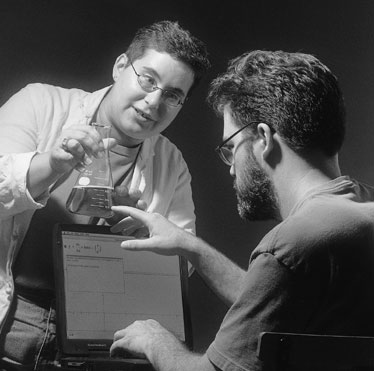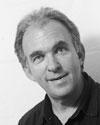
Fall
2002
Fall 2002
In a conversation with soundings contributing editor Orna Feldman, Professor Joshua Cohen discusses freedom of expression, campaign finance reform, and the trouble with political philosophy today.
Recipients of the Spring 2002 SHASS Infinite Mile Awards were announced in May.
Science Writing Program opens its doors
MIT's new graduate program in science writing hopes to influence both the discipline of science writing and the public understanding of science and technology.
The Burchard Scholars Program makes room in the MIT universe for questions without answers.
![]()
![]()
Soundings is published by the Dean's Office of the
School of Humanities, Arts, and Social Sciences at MIT
Comments and questions to shass-www@mit.edu
Science Writing Program opens its doors

MIT's commitment to science writing sends a message about the importance of public involvement in issues of science and technology.
Photo: Graham G. Ramsay.
MIT's Science Writing Program welcomed its first seven students this fall, in what promises to be an exciting new development in the Institute's commitment to the public understanding of science. The new master's degree program, which has been in the planning stages for several years, is led by Robert Kanigel, Professor of Science Writing. The program consists of one year of coursework, a 40-page thesis, and a summer internship.
The rich array of faculty members who will be teaching in the new program include Pulitzer Prize-winning medical writer B.D. Colen; Alan Lightman, author of Einstein's Dreams; Kenneth Manning, a finalist for the National Book Award and the Pulitzer Prize; Professor James Paradis, head of the Writing program and author of T.H. Huxley: Man's Place in Nature; and Boyce Rensberger, director of the Knight Science Journalism Fellowships, formerly of the New York Times and the Washington Post.
Kanigel is the author of The Man Who Knew Infinity and recipient of the Grady-Stack award in science writing by the American Chemical Society. The program will also take advantage of MIT's deep science and writing resources, including the Science, Technology, and Society Program, the Knight Science Journalism Fellowships, the Comparative Media Studies Program, and MIT's numerous scientific and engineering laboratories.
Conceiving and implementing a new degree program at MIT is, of course, a complicated challenge. Every new program at the Institute must be approved by a full vote of the faculty—only the most visible hurdle in a long series of approvals and procedures. Undertaking this process, and carrying it through to a successful conclusion, requires vision, foresight, conviction, and a healthy dose of entrepreneurial spirit.
The Science Writing Program, however, has enjoyed a relatively smooth ride through this complex process. Philip Khoury, Kenan Sahin Dean of the School of Humanities, Arts, and Social Sciences, suggests that this lack of institutional turbulence stems from the fact that the program is such an obvious fit for MIT. "The Science Writing Program is something that people across the Institute have immediately embraced intellectually," he explains. "It makes sense; and it takes advantage of areas in which MIT already demonstrates a lot of depth."
The program still has some important milestones to achieve. Dean Khoury outlines the first priority: "Full funding for our graduate students will be an important step in making this program successful. A grad student at MIT costs upwards of $40,000 per year, and we need to raise roughly $4 million in endowment to make this program fully self-sustaining." In the longer term, the program hopes to build up its endowment further, to cover faculty positions and operational needs.
The organizational process, which has been moving along on the parallel tracks of the curricular and the administrative, has also been relatively smooth. Ironing out the kinks in the curriculum before the students arrive has been a major focus of the faculty members. "The program is obviously going to change," explains Kanigel, "but we want the people in this first year to have a substantive, useful, enriching, and exhilarating experience."
Kanigel has also been overseeing the mundane but crucial details that attend any new venture. "Phones, space, chairsāall these 'little' things had to be decided," he elaborates. "Logistical details. We had to set up an admissions committee. And, of course, we had to figure out how to get the word out."
To meet that challenge, Kanigel's team sent information to more than 6500 university departments and individuals, and also advertised through the American Society of Journalists and Authors, the National Association of Science Writers, and others. The goal—which has been met successfully—was to make the program selective from the first year. From more than 500 inquiries, the program received 40 applicants. According to Kanigel, the admissions committee found itself in the "delicious position of having to make painful decisions."
 The program does not focus solely on science journalism. Instead, Kanigel hopes that the program will be what he calls a "big tent." The goal is to provide meaningful support to students whatever their scientific and literary interests may be.
The program does not focus solely on science journalism. Instead, Kanigel hopes that the program will be what he calls a "big tent." The goal is to provide meaningful support to students whatever their scientific and literary interests may be.
"Whether the students ultimately want to write newspaper articles or books; whether they want to influence the world; whether they simply want to explain a complex world that sometimes seems too fast . . . we want students to find mentors and gain experience here that will prepare them to pursue careers in any area that interests them," says Kanigel. "We want them to come in with an open mind, and take advantage of the extraordinarily rich resources that we can offer them."
The students who will be the first graduates of the program are a diverse bunch, with wide-ranging interests. The focus of the entering class is about evenly split between the physical and the biological sciences. Some are recent college graduates, while others have been working in the field for a while. One consistent element is an interest and involvement in both the sciences and the arts and humanities.
Another shared attribute? They're already good writers, even before they start the program. This is important, because in a one-year program, there's little room for the remedial.
In fact, Kanigel predicts that the combination of the Advanced Science Writing Seminar,
the thesis, and two electives will make for a very busy year. "We have to strike a balance," he says. "If the students are forced to write too much, their work will lose richness and depth. We want the experience to be memorably intense, but no more."
The program doesn't lack for ambition: It hopes to influence both the field of science writing and also society at large. With several strong science writing programs already in existence across the country, this might seem presumptuous. But MIT's program hopes to be unique in the field in insisting that its students never shy away from the science itself, no matter how difficult, in their writing. According to Alan Lightman, the "thorough knowledge of science will be a particular trademark of the program, and we hope that it will be recognized by other programs in the country."
As for influencing society? Again, Alan Lightman: "We live in an age of increasing dependence on science and technology, yet oftentimes the citizens of our country don't have enough understanding of science and technology to participate in decision-making. For an institution dedicated to science and technology to have a graduate program in science writing for the public conveys the message that we feel that the public should be involved with the scientific enterprise. I believe that it's a critical message for the country as a whole, and a powerful statement about the importance of all citizens in a democracy participating in issues of science and technology."
Kanigel agrees, citing the need to bridge the gap between those who understand science and those who find it intimidating. "The larger social work of science writing," he explains, "is to re-enfranchise the large piece of the population that is not comfortable with most of the technologies that are coming along, and leave them feeling not only knowledgeable, but also more comfortable and at home in their world."
The public awareness of science;
taking the long view
MIT's new Science Writing Program is an important manifestation of the Institute's commitment to the public understanding and awareness of science, technology, and medicine. It is also a natural fit for MIT, the leading institution in the world focusing on science and technology. It is not, however, the first step that the Institute has taken in this direction. In fact, MIT has long been cognizant of its responsibility to translate the complex work done within the Institute to the world at large.
According to Dean Philip Khoury, "As science and technology become more and more complex, institutions must think more about making them intelligible. The administration has felt for a long time that MIT ought not just to be producing all this leading edge science and technology, but also explaining why we do this research, and how it relates to today's world. And this is not limited to what we produce here at MIT, but also encompasses the research that the rest of the world produces."
The Science, Technology, and Society Program (STS) was the first program at SHASS to focus on this issue as part of its mandate. Celebrating its twenty-fifth anniversary this year, STS is one of the oldest and largest programs of its kind in the country. The program—which offers both an undergraduate and a PhD degree—attempts to increase understanding of the human-built world. STS addresses two basic, interrelated questions: How did science and technology evolve as human activities, and, how do they relate to the larger civilization?
The STS perspective has become of critical importance in understanding a host of public issues such as privacy, democracy, the environment, medicine, education, and national and global security.
In 1983, SHASS continued along this path with the development of a mid-career Science Journalism program. Originally called the "Bush Fellowships," the program was later renamed the "Knight Science Journalism Fellowships." The year-long program offers science journalists the opportunity to explore areas of science and technology more deeply through seminars, laboratory visits, and field trips. Many of the seminars are devoted to the interactions between science and society.
Comparative Media Studies (CMS), a program that studies the social, cultural, legal, political, and ethical implications of digital technologies, was added to the mix in 1999. Henry Jenkins III, the Ann Fetter Friedlaender Professor of Humanities and director of CMS, defined CMS's role in a 1998 interview with Tech Talk as "explaining the potential and consequences of the digital revolution."
The new Science Writing Program is thus the fourth component in MIT's ongoing commitment to the public understanding of science and technology. Already, the programs are creating exciting synergies. Dean Khoury looks forward to a time when the four parts will be more closely connected, perhaps under the umbrella of a larger Center or Institute focusing on the public awareness of science, technology, and medicine.
"MIT now has considerable strengths in these four different areas," he explains, "each dealing in some form or another with the public awareness of science, and each focusing on different points in a professional's career. Integrating these programs more closely will solidify MIT's leadership in the public understanding of science, and provide a strong example for other institutions of higher learning . . . and for the world at large."
![]()
Copyright © 2002 Massachusetts Institute of Technology